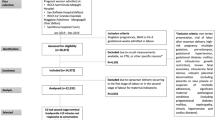Summary
Using Prechtl's concept of optimal conditions as modified by Michaelis et al. [7] we analysed the case records of 50 acidotic newborn infants (umbilical artery pH of 7,250 or less) and of 34 controls. Acidotic infants had a significantly higher negative (or adverse) factor score. There was a correlation between the degree of acidosis and the negative factor score. There were, however, no relations between scores in isolated subgroups of negative factors and fetal acidosis though the same was not true for some combinations of subgroups (such as pre-eclampsia, operative delivery, fetal bradycardia in the second stage of labour).
Similar content being viewed by others
References
Caldwell BM, Graham FK, Pennoyer MM (1957) The utility of blood oxygenation as an indicator of postnatal conditions. J Pediatr 50: 434–445
Corah NL, Anthony EJ, Painter P, Stern JA, Thurston DL (1965) Effects of perinatal anoxia after seven years. Psychol Monograph 79: 1–32
Friedman EA, Niswander KR, Sachtleben MR, Naftaly N (1969) Dysfunctional labor. Part X, Immediate results to infant. Obstet Gynecol 33: 776–784
Graham FK, Ernhart CB, Thurston D, Craft M (1962) Development three years after perinatal anoxia and other potentially damaging newborn experiences. Psychol Monograph 76: 1–53
Kloos K, Vogel M (1974) Pathologie der Perinatalperiode. Thieme, Stuttgart
Knox EG, Mahon EF (1970) Evaluation of “Infant at Risk” registers. Arch Dis Child 45: 634–639
Michaelis R, Dopfer R, Gerbig W, Dopfer-Feller P, Rohr M (1979) Die Erfassung obstetrischer und postnataler Risikofaktoren durch eine Liste optimaler Bedingungen. Monatsschr Kinderheilkd 127: 149–155
Neutra R, Neff R (1975) Fetal death in eclampsia. Br J Obstet Gynecol 82: 390–396
Niswander KR, Gordon M, Drage JS (1975) The effect of intra-uterine hypoxia on the child surviving to four years. Am J Obstet Gynecol 121: 892–899
Oppe TE (1967) Risk registers for babies. Dev Med Child Neurol 9: 13–21
Otto S (1977) Die reduzierte prä- und perinatale Optimalität bei Neugeborenen mit natalen Azidosen. Inauguraldissertation, Tübingen
Parmelee SH, Michaelis R (1971) Neurological Examination of the Newborn. In: Hellmut J (ed) Exceptional infant, vol 2. Brunner/Mazel, New York, Butterworth's, London, pp 3–23
Prechtl HFR (1968) Neurological findings in newborn infants after pre- and paranatal complications. In: Jonix JHP, Visser HKA (eds) Aspects of prematurity and dysmaturity. Stenfert, Kroese, Leiden, pp 303–321
Rogers MGH (1968) Risk registers and farly detection of handicaps. Dev Med Child Neurol 10: 651–661
Rüttgers H (1973) Einfluß geburtshilflicher Operationen auf die fetale Oxygenation. In: Dudenhausen JW, Saling E (Hrsg) 5. Deutscher Kongreß für Perinatale Medizin, Berlin 1972. Thieme, Stuttgart, S 281–282
Sachs L (1968) Statistische Auswertungsmethoden. Springer, Berlin Heidelberg New York
Schlotter CM, Michaelis R, Otto S, Dopfer R (1981) Beziehungen zwischen reduzierter obstetrischer und perinataler Optimalität und neonataler Azidose. In: Schmidt E, Dudenhausen JW, Saling E (Hrsg) 9. Deutscher Kongreß für Perinatale Medizin, Berlin 1979. Thieme, Stuttgart, S 245–246
Siegel S (1956) Non parametric statistics for the behavioral sciences. Graw-Hill Book Comp, New York Toronto London
Tejani N, Mann LJ, Bhaktharasthsalan A, Weiss RR (1975) Prolonged fetal bradycardia with recovery — its significance and outcome. Am J Obstet Gynecol 122: 975–978
Wulf H (1969) The causes and origin of fetal hypoxia and acidosis. In: Huntingford PJ, Hüter A, Saling E (eds) I. European Congress of Perinatal Medicine, Berlin 1969. Thieme, Stuttgart, S 130–131
Author information
Authors and Affiliations
Rights and permissions
About this article
Cite this article
Schlotter, C.M., Michaelis, R., Otto, S. et al. Evaluation of infants with acidosis using a perinatal “Negative factor” score. Arch. Gynecol. 231, 111–118 (1982). https://doi.org/10.1007/BF02111662
Received:
Accepted:
Issue Date:
DOI: https://doi.org/10.1007/BF02111662




